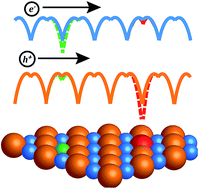Higher mobility in bulk semiconductors by separating the dopants from the charge-conducting band – a case study of thermoelectric PbSe
Abstract
In the rigid band approximation dopants in semiconductors only change the Fermi level and carrier concentration such that different dopants are thought equivalent when fully ionized. In this work we examine the small but significant difference in mobility due to the type of dopant in heavily doped PbSe by studying n-type samples doped with Br, In and Bi. We propose that cation and anion dopants lead to a difference in mobility at high concentrations. This can be understood considering the predominance of cation states to the conduction band and anion states to the valence band. For higher mobility and better performance for most applications of heavily doped semiconductors, dopants should be on the site that is of less influence on the charge-conducting band. This concept can be viewed as an analog of modulation doping on the atomic level. Its physical origin is the random potential due to disorder that perturbs carriers, which is also the origin of Anderson localization at low temperature, a well-studied topic in theoretical physics. In thermoelectric PbSe, the selection of dopant can lead to 10% difference in mobility and in zT.


 Please wait while we load your content...
Please wait while we load your content...